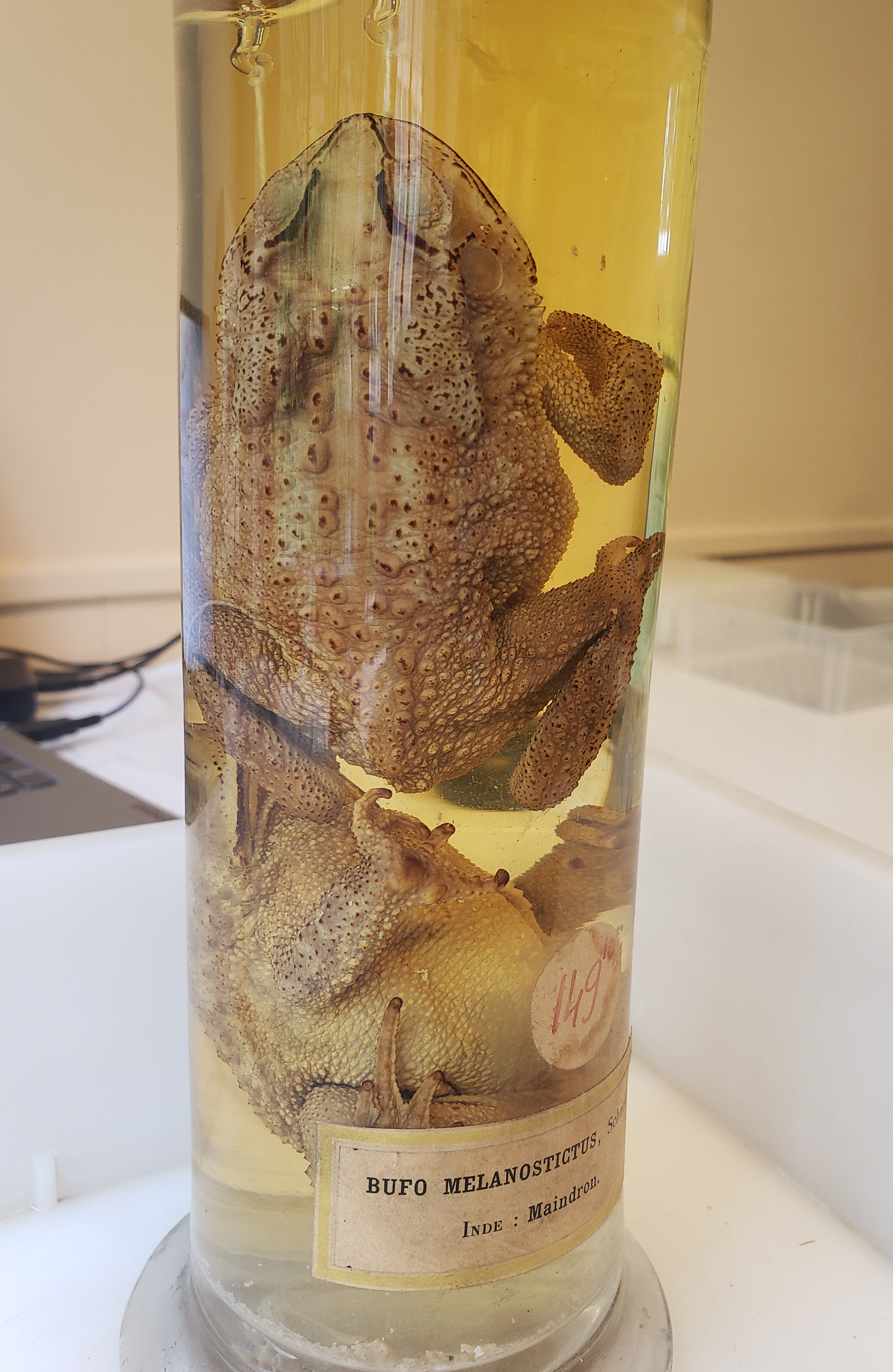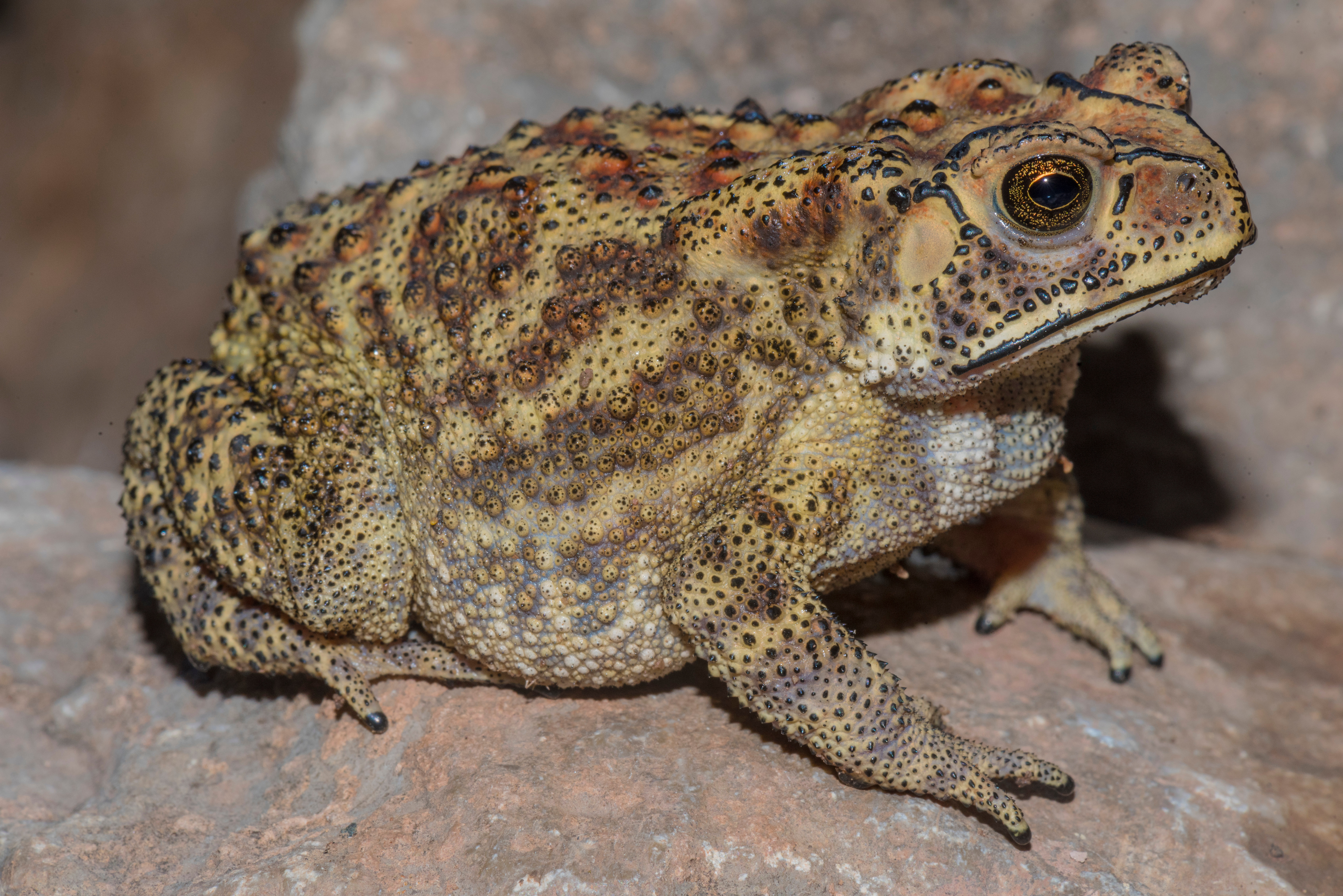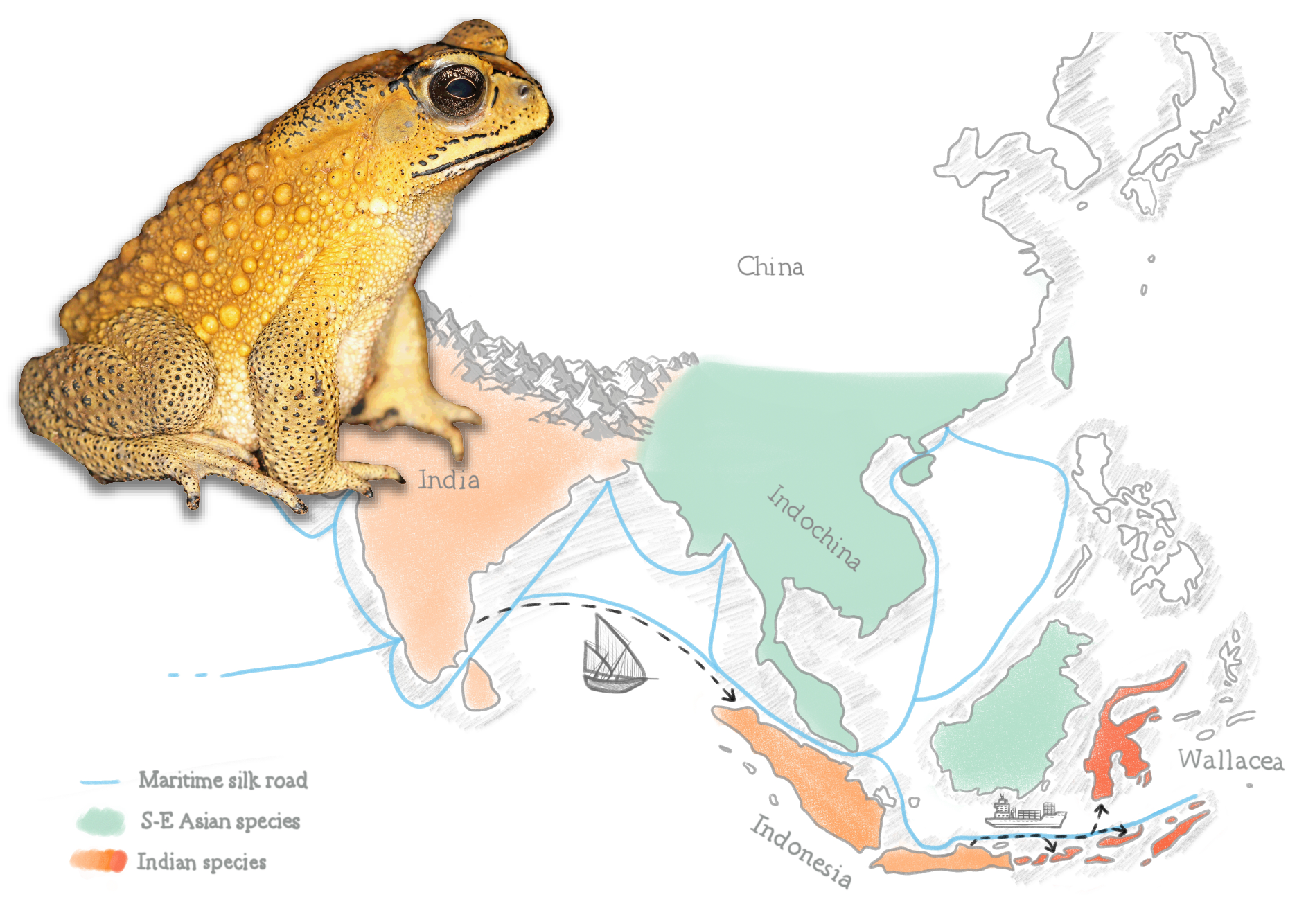Toxic toads on the silk roads: the surprising evolutionary history of a “most-wanted” invasive amphibian
Published in Social Sciences and Ecology & Evolution

Widespread from Pakistan to Indonesia and living close to human settlements, the Asian black-spined toad, better known by its scientific name Duttaphrynus melanostictus, regularly travels as a stowaway in ships and planes. Consequently, it was introduced in many places around the globe and even became invasive in Madagascar and in Wallacea, two of Earth’s biodiversity hotspots. The species is black-listed in many countries such as Australia, which sees in D. melanostictus another potential ecological catastrophe similar to the invasion of the infamous cane toad.
When stressed, the Asian black-spined toad secretes a cardiotoxic substance, which ingestion can be a cause of death, including for people – research showed interference of the toxins with the physiology of human blood cells1. Species regularly preying on the toads have co-evolved inhibitors to the toxins, but most predators in introduced ranges such as snakes, lizards and lemurs are naïve and susceptible to them2. As such, D. melanostictus is considered an emerging threat for many vertebrates, potentially including iconic species like the Komodo dragon in Wallacea3.
Despite these fascinating prospects, it was the complex evolutionary history of D. melanostictus that initially sparked our interest. A few years ago, when preparing a species list of Central and East Asian amphibians for a comparative zoogeography review4, Spartak Litvinchuk and I were perplexed by the high genetic diversity identified by various molecular studies focusing on D. melanostictus. Spartak even shared unpublished estimates of genome sizes that suggested substantial differences between the populations from Southeast and South Asia – the kind of which usually underlies distinct species. Yet the information available at the time was insufficient to draw any conclusions, especially as it mainly relied on a few genes sequenced independently by different research groups in different geographic areas. Plus these were mitochondrial DNA genes, which our team openly distrust when it comes to identifying new species5.
Determined to settle this case, we turned to Nikolay Poyarkov and Daniel Jablonski, two experts of the Asian herpetofauna. Through our combined networks, we developped an international collaboration encompassing no less than 30 researchers active in the many countries inhabited by the toads. Our ambition was to re-examine the evolutionary history of D. melanostictus at the global scale with various methods of DNA analyses, including the sequencing of thousands of markers spread across the whole genome. Given the challenges of obtaining samples from everywhere across the huge range of the species, we also relied on museum collections. As our study neared completion, I coincidently started a position as amphibian curator at the Muséum National d’Histoire Naturelle (MNHN) in Paris and had a front-row seat to analyze voucher specimens from areas that are difficult to access nowadays. In parallel, two rising herpetologist talents from India, Kumudani Bala Gautam and Vishal Kumar Prasad, generated key new sequences that filled important sampling gaps.

Early 20th century specimens of Asian black-spined toad from India, curated at MHNH, Paris, that could be identified by genetic analyses (© Christophe Dufresnes).
The results confirmed our initial hypothesis. Duttaphrynus melanostictus diversified throughout Asia within the last seven million years and consist of at least two distinct species: one in Southeast Asia (Vietnam, Laos, Myanmar, Cambodia, Thailand, Malaysia, China) that was introduced to Madagascar, and another one in South Asia (India, Sri Lanka, Pakistan, Nepal) and Indonesia that was introduced to Wallacea. Their boundary corresponds to the Patkai Hills at the Indian-Myanmar border.
There was one major trick though. Following past hybridization, mitochondrial DNA related to the Southeast Asian species is found all over the Himalayan foothills of North India, Nepal and Pakistan, i.e. deep inside the range of the South Asian species. Such discrepancy had profound consequences. After noticing the Southeast Asian mitochondrial lineage in North India, our collaborators had previously suggested to call it “Duttaphrynus bengalensis”, a name proposed for the populations of Northeast India by the French zoologist François Marie Daudin in 18026. We now know that the whole of India (including these "bengalensis" populations) is inhabited by the South Asian species, which corresponds to the “real” D. melanostictus.
Thus, today the Southeast Asian species still lacks a name. Several potential candidate names exist, but their choice is pending further research to clarify which one should apply in respect to international rules of zoological nomenclature. This will be an important step as the scientific naming of the Southeast Asian species will then be followed by the legislation surrounding the toads, for instance in Madagascar where they are invasive.

An even more unexpected result of our study was the presence of the South Asian species in Indonesia. India and Indonesia are separated by thousands of kilometers of lands or ocean, yet Indonesian toads are genetically identical to those from South India. This implies that they did not reach Indonesia by themselves but were probably brought there by humans. It must have happened a long time ago given that they have managed to spread all over the archipelago since their arrival, and early 20th century zoologists already knew about them7.
One possible pathway of introduction is the maritime silk road, a famous historical trading route, which, according to the archeological records, has connected India and Indonesia for more than two millennia. The economic links offered by the route contributed to the cultural similarities and even shared genetic ancestry between the Indonesian and Indian people. The toads had plenty of opportunities to make such a trip, either as stowaway, or even by been taken along voluntarily. This is not unlikely given that amphibians like D. melanostictus have had a religious and pharmaceutical importance in Asian folklore for millennia8.

Photograph of the Asian black-spined toad from Thailand (© Christophe Dufresnes) and artwork summarizing the distribution ranges of the two species its is composed of (© Johanna Ambu). The presumed arrival of the toad from India (light orange) to Indonesia (orange) by the maritime silk road is illustrated by the sailing ship, and its subsequent expansion into Wallacea (red) within the last decades is illustrated by the container ship.
This situation exemplifies how the world globalization has shaped biodiversity since ancient times, even when the human population was far smaller. The present-day invasion of Wallacea, which was sourced from Indonesia, thus appears to be the contemporary follow-up of an older invasion initiated by our elders.
Nowadays, the evolutionary framework set up by our study gives a basis for a better understanding of the present and future invasions. The Malagasy fauna may face a different threat than the Wallacean fauna, since the invasive toads involved belong to distinct species. The next steps will be to compare their natural history, especially their level of toxicity and the sensitivity of potentially affected predators, to make specific recommendations for wildlife managers.
References
- Bebal, F. F.,Bagwe,A.D., D’Souza, R. C. & Sharma, B. B. Identifying toxic effects and metabolic perturbations of Duttaphrynus melanostictus skin extracts in human erythrocytes Toxicol. Res. 13, tfae086 (2024).
- Marshall, B. M. et al. Widespread vulnerability of Malagasy predators to the toxins of an introduced toad. Curr. Biol. 28, R654–R655 (2018).
- Ujvari, B., Mun, H. C., Conigrave, A. D., Ciofi, C. & Madsen, T. Invasive toxic prey may imperil the survival of an iconic giant lizard, the Komodo dragon. Conserv. Biol. 20, 363–365 (2014).
- Dufresnes, C. & Litvinchuk, S. N. Diversity, distribution and molecular species delimitation in frogs and toads from the Eastern Palearctic. Zool. J. Linn. Soc. 195, 695–760 (2022).
- Dufresnes, C. & Jablonski, D. A genomics revolution in amphibian taxonomy. Science 377, 1272 (2022).
- Jablonski, D., Masroor, R. & Hofmann, S. On the edge of the Shivaliks: An insight into the origin and taxonomic position of Pakistani toads from the Duttaphrynus melanostictus complex (Amphibia, Bufonidae). Zoosyst. Evol. 98, 275–284 (2022).
- vanKampen, P. N. The Amphibia of the Indo-Australian Archipelago (Brill, 1923).
- Pradhan, S., Mishra, D. & Sahu, K. R. Herpetofauna used as traditional medicine by tribes of Gandhamardan Hills Range of Western Orissa, India. Int. J. Res. Zool. 4, 32–35 (2014)
Follow the Topic
-
Nature Communications

An open access, multidisciplinary journal dedicated to publishing high-quality research in all areas of the biological, health, physical, chemical and Earth sciences.
Related Collections
With Collections, you can get published faster and increase your visibility.
Women's Health
Publishing Model: Hybrid
Deadline: Ongoing
Advances in neurodegenerative diseases
Publishing Model: Hybrid
Deadline: Dec 24, 2025



Please sign in or register for FREE
If you are a registered user on Research Communities by Springer Nature, please sign in